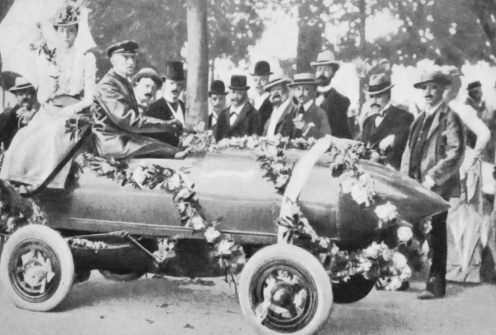
On May Day 1899, the first man to drive a car over 100 kmph was Camille Jenatzy, whose world record was set in Paris driving an electric vehicle with a striking body. As he sat on La Jamais Contente bedecked with flowers and his girl, he appeared to announce to the world that electricity was the future of motoring.

It was a future that very nearly came true in 1900, and looks all set to come true in 2021. Back then, electricity appeared to be a far better option than petrol, delivering silent, reliable, easy to drive cazrs. Had it not been for global petrol companies and car makers like Ford, that better option would have been ruling the roads a century or more earlier. Let's see what electricity had to offer in 1900. Between 1896 and 1939, around 560 companies made electric cars. The USA was their biggest base.

Electric Cars
Taxi fleets in cities like New York and Boston used electrobat cars made by Morris and Salom, which had Electronics, and were compact and reliable. They were sold in limited numbers in Calcutta for use in jute mills, mines and factories with electricity driven machines. In London, electric taxis delivered reliability and ease of driving, and some were sold in Calcutta. Sadly, they needed recharging every 30 miles, or to have exhausted batteries exchanged with fresh charged ones on loan. To be fair, petrol cars were not much better. But it was easier pouring liquid into a tank than exchanging a heavy battery. So promising was electricity that the first car designed by Ferdinand Porsche was the electric wagon shown here.
Hope Dies
There was much press coverage when the American inventor Thomas Alva Edison announced he was developing a new nickel alkali battery that would be light and powerful enough to make electric cars faster than petrol ones and give them longer range. It would put the petrol car out of business as problems of weight and limited range would be solved, promised Edison. Unfortunately this electrifying announcement proved to be a damp squib. When it was launched, it lacked spark and sales of the American Baker electric car pictured here with Edison bottomed out. But in every other way, the electric car looked better. Called runabouts, they were nicknamed 'hummingbirds' as they were silent except for the motor spinning hum like a table fan.

To be – or not to be!
They were safe from fire from commonly leaking petrol pipes, did not emit noxious white oil smoke and offered lovely bodywork. Some came with curved open bodies, some with closed boxes for ladies and others with three box shapes. The problem was their limited range and also the high cost. Driving an electric car announced you were very rich as they cost twice as much as a similar petrol car would. But then, instead of buying petrol at odd stores and chemists (petrol pumps were not yet born), you could recharge it at home. Nonetheless, with Ford Model Ts costing less and less, and larger car costs also coming down, demand was poor. The disadvantages of limited range killed electric cars in the buyer's mind. In a price sensitive market like Calcutta, and India in general, it was fatal.

Today When we still look at the limited success of the Mahindra Reva, and restricted appeal of Formula E-Racing even today, prospects appear daunting. But solutions are within sight and reach. With battery technology developing rapidly and public sentiment exploding against pollution from petrol and diesel emissions (rightly or wrongly), the future of the electric engine under your bonnet appears bright.